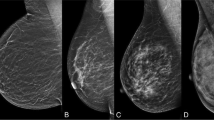Abstract
Background
Abbreviated magnetic resonance imaging (Ab-MRI) has been evaluated for elevated breast cancer risk or dense breasts but has not been evaluated across all risk profiles.
Methods
Patients selected underwent Ab-MRI from February 2020 to September 2021. Women were older than aged 30 years, up to date with screening mammography, and paid $299 cash.
Results
A total of 93 patients were identified with a mean age of 52 years; 92.5% were Caucasian, 0% black, and 97.9% were from high socioeconomic status. Mean Gail score was 14.2, and 83.3% had a lifetime risk of breast cancer <20%. Reasons for Ab-MRI: dense breasts (36.6%); family history (24.7%); palpable mass (12.9%). Providers ordering: OBGYN (49.5%); breast surgeon (39.1%); primary care (6.6%). Thirteen biopsies (14%) detected one breast cancer. 31.1% had a change in follow-up screening: 58.6% 6-month MRI, 20.7% 6-month mammogram, and 10.3% 6-month ultrasound. Negative predictive value was 100% (95% confidence interval [CI]: 95-100%, p < 0.0001). Sensitivity was 100% (95% CI: 2.5-100%, p < 0.0001), and specificity was 87% (95% CI: 78.3-93.1%, p < 0.0001) compared with 77.6% and 98.8% for mammography. Only one cancer was detected: cost of $27,807 plus cost of 13 MRI or ultrasound (US)-guided biopsies and additional follow-up imaging. Historically 20% of abnormalities detected on full MRI are malignant; however, 7.7% of ab-MRI abnormalities were malignant
Conclusions
One third of women were recommended a change in follow-up, which predominantly included a 6-month MRI. Ab-MRI may introduce average risk women to unnecessary follow-up and increased biopsies with a lower cancer detection rate. Ab-MRI should be evaluated closely before implementation.
Similar content being viewed by others
References
Løberg M, Lousdal ML, Bretthauer M, Kalager M. Benefits and harms of mammography screening. Breast Cancer Res. 2015;17:63. https://doi.org/10.1186/s13058-015-0525-z.
Leithner D, Wengert GJ, Helbich TH, et al. Clinical role of breast MRI now and going forward. Clin Radiol. 2018;73(8):700–14. https://doi.org/10.1016/j.crad.2017.10.021.
Kuhl CK, Schrading S. More Is more: semiannual breast MRI screening in BRCA1 mutation carriers. Clin Cancer Res. 2019;25(6):1693–5. https://doi.org/10.1158/1078-0432.CCR-18-3145.
Mango VL, Goel A, Mema E, Kwak E, Ha R. Breast MRI screening for average-risk women: a monte carlo simulation cost-benefit analysis. J Magn Reson Imaging. 2019;49(7):e216–21. https://doi.org/10.1002/jmri.26334.
Kuhl CK, Schrading S, Strobel K, Schild HH, Hilgers RD, Bieling HB. Abbreviated breast magnetic resonance imaging (MRI): first postcontrast subtracted images and maximum-intensity projection-a novel approach to breast cancer screening with MRI. J Clin Oncol. 2014;32(22):2304–10. https://doi.org/10.1200/JCO.2013.52.5386.
Comstock CE, Gatsonis C, Newstead GM, et al. Comparison of Abbreviated breast MRI vs. digital breast tomosynthesis for breast cancer detection among women with dense breasts undergoing screening. JAMA. 2020;323(8):746–56. https://doi.org/10.1001/jama.2020.0572.
Choi BH, Choi N, Kim MY, Yang JH, Yoo YB, Jung HK. Correction to: usefulness of abbreviated breast MRI screening for women with a history of breast cancer surgery. Breast Cancer Res Treat. 2018;167(2):503. https://doi.org/10.1007/s10549-017-4568-y.
Kuhl CK. The changing world of breast cancer: a radiologist’s perspective. Plast Surg Nurs. 2016;36(1):31–49. https://doi.org/10.1097/PSN.0000000000000128.
Geach R, Jones LI, Harding SA, et al. The potential utility of abbreviated breast MRI (FAST MRI) as a tool for breast cancer screening: a systematic review and meta-analysis. Clin Radiol. 2021;76(2):154.e11-154.e22. https://doi.org/10.1016/j.crad.2020.08.032.
Kolb TM, Lichy J, Newhouse JH. Comparison of the performance of screening mammography, physical examination, and breast US and evaluation of factors that influence them: an analysis of 27,825 patient evaluations. Radiology. 2002;225(1):165–75. https://doi.org/10.1148/radiol.2251011667.
Siu AL. Screening for breast cancer: U.S. preventive services task force recommendation statement. Ann Intern Med. 2016;164(4):279. https://doi.org/10.7326/M15-2886.
Nakhleh RE, Zarbo RJ. Surgical pathology-based outcomes assessment of breast cancer early diagnosis: a college of American Pathologists Q-probes study in 199 institutions. Arch Pathol Lab Med. 2001;125(3):325–31. https://doi.org/10.5858/2001-125-0325-SPBOAO.
Cserni G, Chmielik E, Cserni B, Tot T. The new TNM-based staging of breast cancer. Virchows Arch. 2018;472(5):697–703. https://doi.org/10.1007/s00428-018-2301-9.
Gao LY, Gu Y, Tian JW, et al. Gail Model Improves the Diagnostic Performance of the Fifth Edition of Ultrasound BI-RADS for Predicting Breast Cancer: A Multicenter Prospective Study. Acad Radiol. 2020. https://doi.org/10.1016/j.acra.2020.12.002.
Partridge SC, Nissan N, Rahbar H, Kitsch AE, Sigmund EE. Diffusion-weighted breast MRI: Clinical applications and emerging techniques. J Magn Reson Imaging. 2017;45(2):337–55. https://doi.org/10.1002/jmri.25479.
Partovi S, Sin D, Lu Z, et al. Fast MRI breast cancer screening - Ready for prime time. Clin Imaging. 2020;60(2):160–8. https://doi.org/10.1016/j.clinimag.2019.10.013.
Kind AJ, Jencks S, Brock J, et al. Neighborhood socioeconomic disadvantage and 30-day rehospitalization: a retrospective cohort study. Ann Intern Med. 2014;161(11):765–74. https://doi.org/10.7326/M13-2946.
Freedman RA, Kouri EM, West DW, Keating NL. Racial/ethnic disparities in knowledge about one’s breast cancer characteristics. Cancer. 2015;121(5):724–32. https://doi.org/10.1002/cncr.28977.
Smith KL, Isaacs C. Management of women at increased risk for hereditary breast cancer. Breast Dis. 2006;2006–2007(27):51–67. https://doi.org/10.3233/bd-2007-27104.
Vlahiotis A, Griffin B, Stavros AT, Margolis J. Analysis of utilization patterns and associated costs of the breast imaging and diagnostic procedures after screening mammography. Clinicoecon Outcomes Res. 2018;10:157–67. https://doi.org/10.2147/CEOR.S150260.
Vourtsis A, Berg WA. Breast density implications and supplemental screening. Eur Radiol. 2019;29(4):1762–77. https://doi.org/10.1007/s00330-018-5668-8.
Jost G, Frenzel T, Boyken J, Lohrke J, Nischwitz V, Pietsch H. Long-term excretion of gadolinium-based contrast agents: linear versus macrocyclic agents in an experimental rat model. Radiology. 2019;290(2):340–8. https://doi.org/10.1148/radiol.2018180135.
Kanda T, Ishii K, Kawaguchi H, Kitajima K, Takenaka D. High signal intensity in the dentate nucleus and globus pallidus on unenhanced T1-weighted MR images: relationship with increasing cumulative dose of a gadolinium-based contrast material. Radiology. 2014;270(3):834–41. https://doi.org/10.1148/radiol.13131669.
Acknowledgment
Thank you to the breast cancer team at Main Line Health for making this study possible and always working to improve the care of our breast cancer patients. There was grant support for this work from the Sharpe Strumia Foundation Grant number SSRF2021-11.
Author information
Authors and Affiliations
Corresponding author
Additional information
Publisher's Note
Springer Nature remains neutral with regard to jurisdictional claims in published maps and institutional affiliations.
Rights and permissions
About this article
Cite this article
Kennard, K., Wang, O., Kjelstrom, S. et al. Outcomes of Abbreviated MRI (Ab-MRI) for Women of any Breast Cancer Risk and Breast Density in a Community Academic Setting. Ann Surg Oncol 29, 6215–6221 (2022). https://doi.org/10.1245/s10434-022-12194-9
Received:
Accepted:
Published:
Issue Date:
DOI: https://doi.org/10.1245/s10434-022-12194-9



